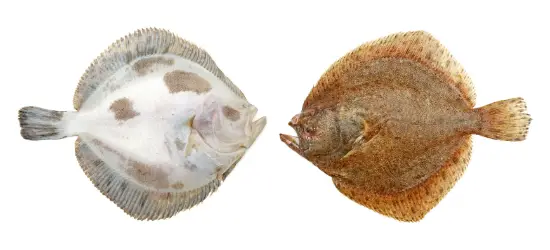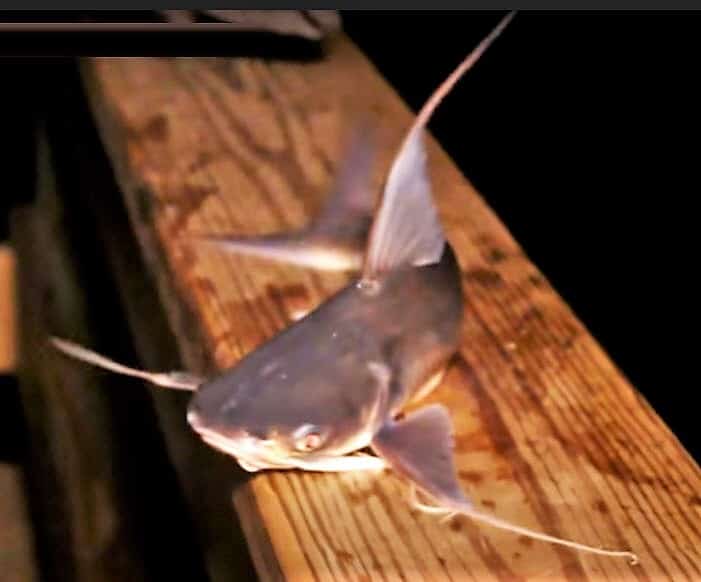What Saltwater Fish Can You Catch Off Of A Pier?
Are you a beginner at pier fishing who does not know what fish you can catch? This is common, but no worries! You will soon be a pier fishing expert!
In this article, you will learn about the most common saltwater fish caught pier fishing:
- Speckled Trout (Spotted Seatrout)
- Redfish (Red Drum)
- Flounder
- Gafftopsail Catfish
- Black Drum
- Common Sharks
- Sheepshead
- Sand Trout
- Atlantic Croaker
- Whiting (Gulf Kingfish)
You will learn:
- How to identify them
- Tips for fishing and handling
- Where they are commonly caught
You will know the fish you want to keep and the size regulations in Florida and Texas.
Let’s get started!
Game Fish Frequently Caught Off A Pier
Here is a quick Texas regulation bag and size limit chart for the U.S. Gulf Coast fish discussed.
If you’re planning on fishing for saltwater fish you can catch off of a pier in Texas, make sure you’re familiar with the Texas fishing regulations.
| Fish | Daily Bag | Min Length | Max Length |
|---|---|---|---|
| Croaker, Atlantic | unlimited | no minimum | no limit |
| Drum, Black | 5 | 14″ | 30″ |
| Drum, Red (Redfish) | 3 | 20″ | 28″ |
| Flounder, Southern | 5 | 15″ | no limit |
| Gafftopsail | unlimited | 14″ | no limit |
| Mackerel, King | 3 | 27″ | no limit |
| Mackerel, Spanish | 15 | 14″ | no limit |
| Seatrout, Sand | 3 | 14″ | no limit |
| Seatrout, Spotted | 5 | 15″ | 25″ |
| Shark, Blacktip | 1 | 24″ | no limit |
| Shark, Bonnethead | 1 | 24″ | no limit |
| Shark, Hammerhead, Great | 1 | 99″ | no limit |
| Shark, Hammerhead, Scalloped | 1 | 99″ | no limit |
| Sheepshead | 5 | 15″ | no limit |
| Whiting | unlimited | no minimum | no limit |
Acquiring A Fishing License And Necessary Tags
Here’s a list of resources where you can get fishing licenses and find the fishing regulations for each Gulf State:
- Texas Parks And Wildlife Department
- Louisiana Department Of Wildlife And Fisheries
- Mississippi Department Of Wildlife, Fisheries, And Parks
- Alabama Department of Conservation and Natural Resources
- Florida Fish and Wildlife Conservation Commission
Just so you know, it’s important for everyone with a fishing rod and reel to have their own fishing license. This rule is enforced by the game warden in each state, and they have the authority to issue fines and even take away any fish you may have caught.
It’s worth mentioning that you can be fined even if you haven’t caught anything yet, so it’s better to be safe and follow the regulations.
Here is an awesome list of licensing costs for each state.
Game Fish Size And Bag Limits
Each state has its own regulations to protect game fish, and they vary. Licenses, fish sizes, and catch limits are closely monitored by state game wardens.
I’ve personally seen pier fishermen getting fined and having their fish confiscated numerous times. Let me provide you with a list of regulations for each Gulf State:
- Texas Saltwater Fishing Regulations
- Florida Saltwater Fishing Regulations
- Louisiana Game Fish LImits And Regulations
- Mississippi Game Fish Limits And Regulations
- Alabama Game Fish Limits And Regulations
Just a heads up, it’s important for each angler to have their own fishing license. The game warden in each state has the authority to issue fines and even confiscate your catch if you’re caught without one.
Surprisingly, you can face penalties even if you haven’t caught any fish yet. So, it’s better to play it safe and make sure you’re properly licensed before casting your line.
Speckled Seatrout
Speckled trout, also known as spotted seatrout, have a predominantly silver color with hints of green and yellow, and their bodies are adorned with black speckles from gills to tail. When handling these fish, be cautious of their two long upper teeth.
What makes speckled trout even more interesting is their behavior as aggressive hunters. They are incredibly swift and have a reputation for stealthily stalking their prey in marshes and shallow waters. It’s no wonder they’re often referred to as the tigers of shallows.
If you’re planning a fishing trip for speckled trout, timing is key. These fish are most active during the early morning or at dusk to early evening. Seasoned anglers often opt for a top-water approach, using live shrimp and a bobber or a dancing topwater lure. By working these baits along the edges of the light, you can catch the attention of these captivating fish.
So, next time you’re out on a fishing trip, keep an eye out for speckled trout and enjoy the excitement of targeting these impressive predators.
Redfish (Red Drum)
Red drum, or redfish as they are more popularly known, are from the drum family and are hearty hunters. If the speckled trout are like tigers, the redfish are the lions. They attack in packs throughout the day, following schools of fish and then ambush their prey. Their tails can be seen breaking the water as they feed.
They vary in color from a dark reddish yellow to a light silvery yellow tinge. And they all have distinctive nickel-sized black dots around the tail and occasionally on the lower back.
They tend to be a hit-and-run feeder off the pier, typically using the current to strike hard. They hit hard and are strong, straight-line runners. Beware the runs with your line under the pier, as they use the pier stacks to cut the line or run to the other side.
These fish are mid-water feeders and will hit dead shrimp, cut bait, or crabs. They are also fond of yellow or silver spoons and occasionally hit topwater lures and jigs.

Flounder
Flounder are some of the best fighters because they know how to use the surface area of their flat bodies effectively. They are strictly bottom feeders and often bury themselves as they wait for their next meal. Although they are solo hunters, they tend to be found in groups.
These fish are flat and oval-shaped with an olive green or brown back, sometimes covered with light specks. Their bellies are white or cream. And interesting enough, both eyes are on the topside for better viewing of prey.
They are known for occupying flatter, calmer water and are found around the first two lights on the pier. Flounder are mostly night hunters that pursue live and dead baits along with spoons and jigs along the bottom.

Gafftopsail Catfish
These creatures are one of the most slimiest fish I have ever come across. Although they are in the catfish family, they do not have poisonous barbs like the hardhead catfish. They have long whiskers along the mouth, dorsal and the pectoral fins.
All catfish are junk eaters, along with dead shrimp. They will nibble the larger cut baits until it is in ribbons. These are edible and a gamefish, but are far less popular then its freshwater cousins.
These fish are the type to nibble and then run when they get hooked. You can always tell when you have a sea catfish on the line by its small jerky action.

Black Drum
Adult black drum size between 20 and 50 pounds. They tend to be black or gray in color with the young displaying black stripes over a grey body.
When hooked, they dive hard and deep. You may not realize you have a fish at all with this fish fighting like pulling an old 55-gallon drum.
Typical pier fishermen will use a heavy sinker to keep the bait securely in the strike zone. As bottom feeders, they hit fish, shrimp and crabs. Squid is a good choice to avoid other smaller species.
The best time to catch one is during the bull drum run along the Gulf Coast between February and late March. Hundreds will travel hundreds of miles consuming huge amounts of bait fish as they spawn.

Shark (bonnethead, hammerhead, blacktip, sand tiger)
Shark fishing requires a different technique and specific equipment. Use a steel wire or a stainless steel leader with a circle hook for easier release. Medium to large varieties have been known to snap rods and break off lines. Smaller ones are manageable with standard fishing tackle and are great fighting foes.
Bloody cutbait with a strong odor such as bonito and barracuda are attractive to all variety of shark. Mullet is another good choice.

Sheepshead
These can get fairly large with large five or six black stripes with spiny fins.
Sheepshead mostly eat crustaceans that they crush with human looking teeth. They also feast on dead shrimp and are notorious nibblers, so small hooks work better.
It is more common to catch these fish along channels and crustacean covered pillars and overpass stacks, although they still frequent piers as well.
Other Non-game Fish Caught On Piers

Sand Seatrout
Unlike its cousins, the speckled seatrout, these seatrouts are generally bottom feeders. Occasionally fishermen will catch one with typical techniques and bait targeting speckled seatrout.
These fish are good fighters and are known to congregate around piers. They can be found along the edges of the lights and in the shadows.
They are usually smaller than the speckled variety, but there have been 9-pounders caught in all the Gulf Coast states.
Dead bait, live bait, soft plastics, jigs, and spinners are successful baits. Jigs and spoons work nice as well.

Golden Croaker
Typical schooling fish that will “run” at a pier and be caught left and right. They are known for their distinctive “croaking” sound. Mostly golden color with a tab under the chin.
You will recognize their bite by the constant nibbles, and they tend to hit and run. The smaller ones are great bait fish for redfish and other gamefish.
Croakers can be quite tasty but are too bony for most people’s taste. An experienced fisherman should be able to handle deboning.

Whiting (Gulf Kingfish)
Whiting is another school and a cousin of the Croaker family. It is commonly mistaken for the Southern and the Northern Kingfish, which are similar in appearance but with vertical bars along the body. They are silvery-white in color and grow to just under 20 inches. The best identification marker is a distinctive white tab under the chin.
Good eating fish without a lot of bones. They tend to have slender filets, so it is recommended to only keep larger ones or with several accompanying fish.
Another bottom feeder that is frequently caught on dead and live shrimp. They are nibblers like most smaller species, and the bite is often confused with croaker and catfish.
Summary
In this article, you learned about the most common saltwater fish caught pier fishing:
- Speckled Trout (Spotted Seatrout)
- Redfish (Red Drum)
- Flounder
- Gafftopsail Catfish
- Black Drum
- Common Sharks
- Sheepshead
- Sand Trout
- Atlantic Croaker
- Whiting (Gulf Kingfish)
You can now know:
- How to identify them
- Tips for fishing and handling
- Where they are commonly caught
Please leave a comment below for any questions or request information on any topics you would like to know more about.







